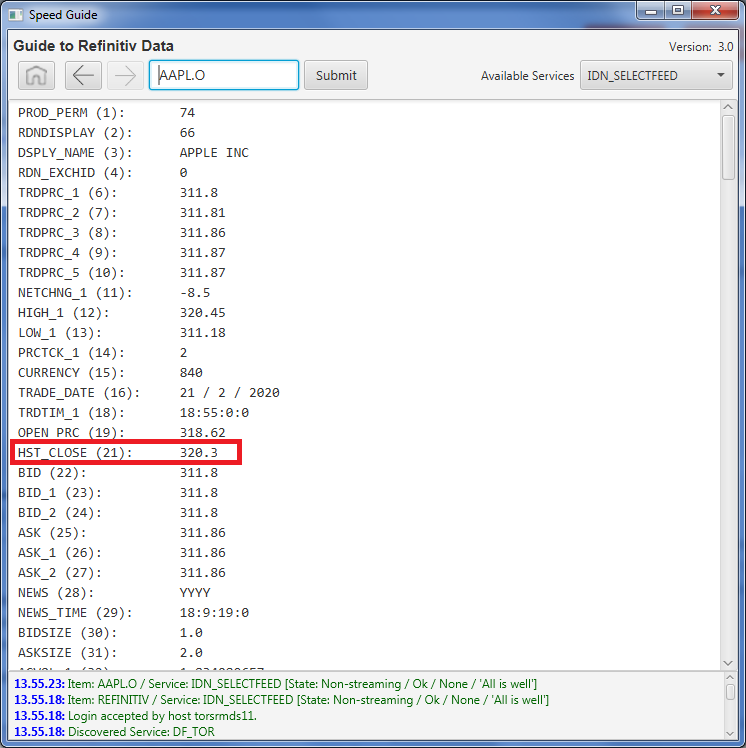Currently we are using ETA C/C++ api to receive real-time market data. Just wonder if we could receive the close price, too, from the same stream? Some posts had suggested to use "TR.CLOSEPRICE" and "TR.PriceClose". But my app reported an error that those 2 fields were not found in the dictionary. Please advise.
- Home
- Anonymous
- Sign in
- Create
- Post an idea
- Create an article
- Spaces
- Alpha
- App Studio
- Block Chain
- Bot Platform
- Connected Risk APIs
- DSS
- Data Fusion
- Data Model Discovery
- Datastream
- Eikon COM
- Eikon Data APIs
- Electronic Trading
- Elektron
- Intelligent Tagging
- Legal One
- Messenger Bot
- Messenger Side by Side
- ONESOURCE
- Open Calais
- Open PermID
- Org ID
- PAM
- ProView
- ProView Internal
- Product Insight
- Project Tracking
- RDMS
- Refinitiv Data Platform
- Rose's Space
- Screening
- Side by Side Integration API
- TR Knowledge Graph
- TREP APIs
- TREP Infrastructure
- TRKD
- TRTH
- Thomson One Smart
- Transactions
- Velocity Analytics
- Wealth Management Web Services
- Workspace SDK
- World-Check Data File
- 中文论坛
- Explore
- Tags
- Questions
- Ideas
- Articles
- Users
- Badges
question
How to query the close price via Elektron ETA C/C++ api?

Hi @ayan@jump,
The ETA C/C++ APIs provide access to real-time streaming services. Within the package you download you can find dictionary files (RDMFieldDictionary) within the <root>/Cpp-C/etc directory. The dictionary files detail all the fields available within the streaming services.
Note: The list of fields available for certain instruments depends on the type of asset, i.e. Equity, Fixed Income etc.
The TR.CLOSEPRICE and TR.PriceClose fields are not available within the streaming services. These fields are associated with our desktop product (Eikon) that retrieve data from a non-streaming reference database.
Any easy way to view content from our streaming services is to use the SpeedGuide Tool. For example, I can see the Historical Close Price for Apple:


Thanks, Nick.
We are interested in how to retrieve the close price automatically in our app.
So you mean that we won't be able to implement this with ETA C/C++ api, right?

Hi @ayan@jump,
What I was showing in my original answer was that you can retrieve the historical closing price within your app using ETA. The screenshot is a simple application built using EMA that displays the historical closing price. So when you build an ETA application, it will automatically deliver the Historical Closing price.
If you are new using Refinitiv APIs to stream data to your application, it might help if you provide some details regarding your Refinitiv data access and the needs of your application. For example, are you accessing streaming data within the Cloud or through deployed services available to you within your environment? Is it critical that your application requires the data to be processed as fast as possible? ETA is ideal for application developers that want total control over how they want to integrate our streaming libraries within their applications. In addition, they provide the highest throughput and lowest latency available. However, the cost of these benefits is the development effort is much greater than other options. For example, EMA C++ is built on top of ETA C but provides ease of use capabilities that most of users choose.
If you haven't already, I would encourage you to visit the Elektron API development page and review the Quick Start and Tutorial guides to get a feeling of what you can do.

We do have an app based on ETA, which is working fine now. I believe what I need to do is to add the field for the close price into our request.
So "HST_CLOSE" is the field name we need to add, right?
How should I interpret the value? Before today's close, it's actually the close price of last session, right? When will today's close price be available in the real-time stream?

Hi @ayan@jump,
HST_CLOSE typically represents the close price of the previous trading day. Today's close price is typically determine during a closing run after the trading day. However, each exchange has it's own rules when the closing is determined.
It's also worth noting that the dictionary file I referenced in my original answer defines different types of closing prices, depending on the type of asset. This site doesn't discuss the nature of our data and what specific fields to use. I would suggest if you have specific questions regarding fields and their meaning would be to open a ticket within the Refinitiv Support Desk.


